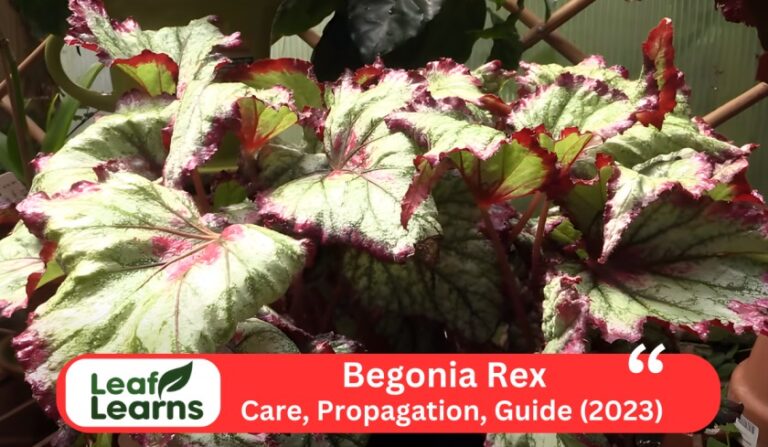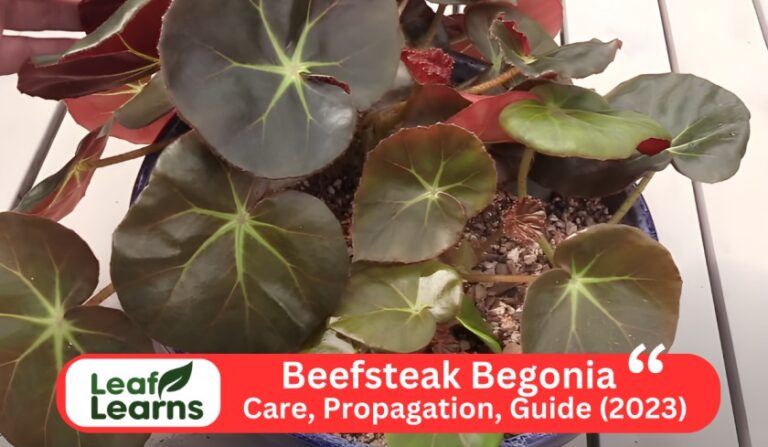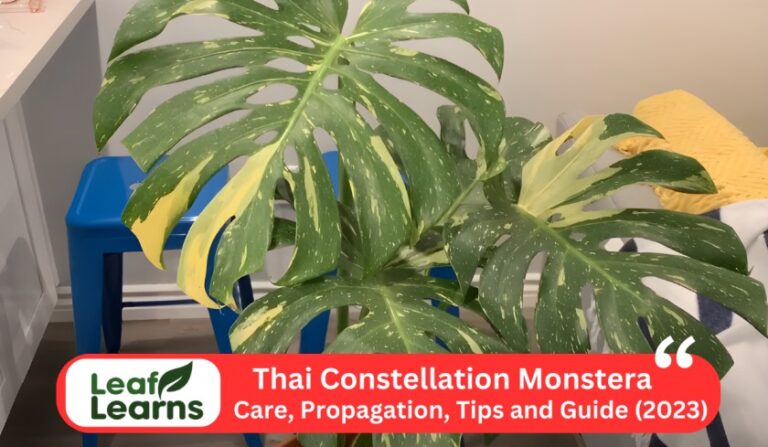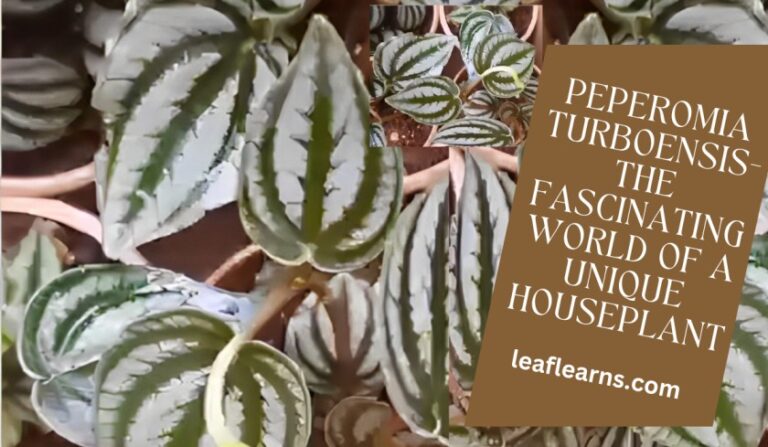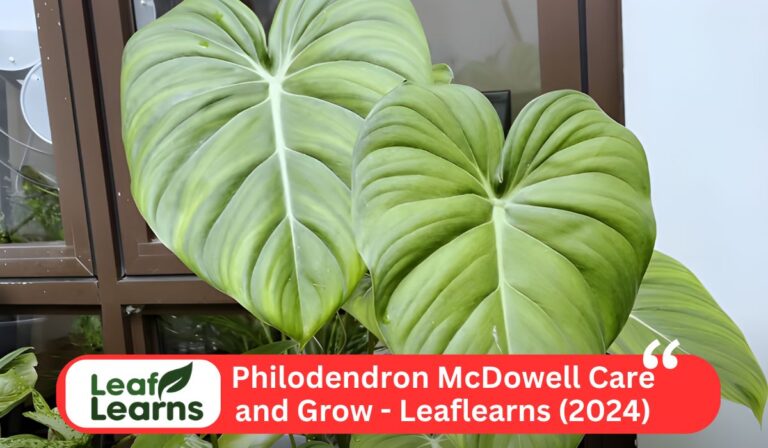Crassula Capitella ‘Crassula Campfire’ Care and Grow (2023)
The Crassula Capitella, sometimes called the campfire succulent, is a succulent native to southern Africa with sun-kissed landscapes. There is something mesmerizing about the way this tiny perennial displays its fiery red leaves that transition from lime green to fiery shades of lime green.
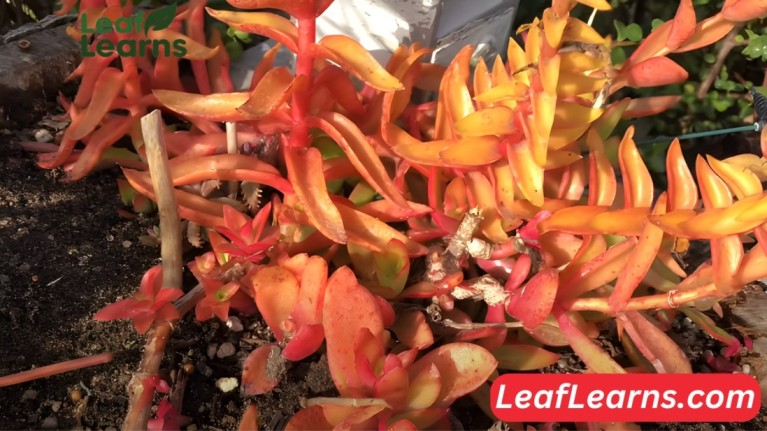
In South Africa’s Eastern Cape, where rocky outcrops and sun-drenched slopes provide ideal environments for the campfire crassula, this plant originated. Despite unpredictable rain patterns in the region, this succulent has adapted to store moisture within its thick, fleshy leaves.
| Common Name | Red Pagoda, Red Flames, Campfire Plant |
| Scientific Name | Crassula-Capitella |
| Family | Crassulaceae |
| Origin | South Africa |
| Plant Type | Succulent |
| Size | 6-8 inches (15-20 cm) in height and up to 3 feet (90 cm) wide |
| Lifespan | Perennial |
| Leaf Colour | Green with red edges when stressed |
| Leaf Size | Small, triangular |
| Flower | Small, star-shaped clusters of white or pink flowers |
| Light | Full sun to partial shade |
| Water | Low to moderate |
| Soil | Well-draining, sandy or loamy soil |
| Temperature | 60-75°F (15-24°C) |
| Humidity | Low |
| USDA Zone | 9-11 |
| Fertilizer | Balanced liquid fertilizer during the growing season |
| Propagation | Stem or leaf cuttings, offsets |
| Pruning | Not usually required, but can be pruned to maintain shape |
| Pests | Mealybugs and aphids |
| Toxicity | Mildly toxic to pets and humans |
| Uses | Ground cover, container gardens, succulent arrangements |
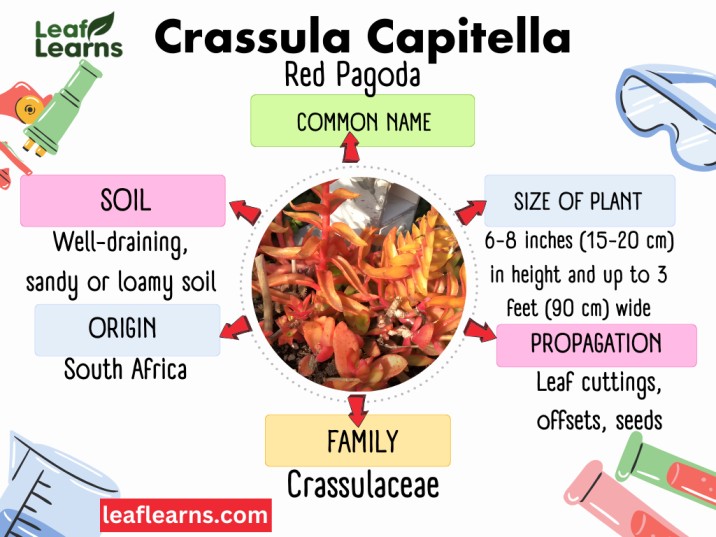
There are mainly rocky crevices and exposed hillsides where Crassula Campfire finds refuge. This red pagoda stands out among the otherwise monotonous landscape because of its vibrant red foliage.
Habitat: A well-drained, sandy soil and ample sunlight are ideal for the campfire crassula. African grasslands, coastal fynbos, and rocky outcrops provide it with a warm natural habitat.
Contents
- 1 What’s Unique About Crassula Campfire?
- 2 Top Care Tips
- 3 Care for Crassula Capitella
- 4 How to Propagating Crassula Capitella
- 5 Growing Problems
- 6 Pruning
- 7 Pruning Techniques
- 8 Repotting
- 9 How to Get Crassula Capitella to Bloom
- 10 Growth Rate and Size
- 11 Flowering and Foliage
- 12 Underwatering and Overwatering
- 13 Common Pests and Diseases
- 14 Problems and Solutions
- 15 Toxicity
- 16 Varieties/Types
- 17 Uses
- 18 Optimal Care for Crassula Capitella: Watering, Sunlight, and Disease Prevention
- 19 Diverse Varieties of Campfire Plant: Campfire, Thyrsiflora, and Propagation Techniques
- 20 FAQs
What’s Unique About Crassula Campfire?
Campfire Crassula is a striking succulent that adds a hint of fiery red to any room. A few of its distinguishing characteristics are:
- A sculptural element is added to its appearance by its fleshy, stacked leaves resembling propellers.
- Red coloration: Its leaves turn vibrant red under bright light and cool temperatures, making it look fiery.
- Groundcover for container gardens or rock gardens with low spread: It spreads gracefully.
- This is a versatile choice for various spaces thanks to its compact size of 6 inches (15 cm) and 3 feet (90 cm).
- Flowers appear every two years in summer, adding a delicate contrast to the foliage’s vibrancy.
Top Care Tips
Crassula Campfire need sun exposure 6-8 hours a day, preferably a south-facing window. Grow lights can provide optimal illumination when sunlight is limited.
Make sure the soil is completely dry between waterings to prevent root rot. Water Campfire Plants less during winter, following their natural arid conditions.
Make sure the soil is well-drained by using a succulent potting mix with coarse sand or perlite, preventing excess water from getting into the roots.
During spring and summer, repot Campfire Plants every 2-3 years to accommodate growth. Ensure the stem sits slightly above the soil line when potting the new plant. Loosen roots gently.
Celebrate Campfire Plant’s uniqueness. Leaves shed naturally during their growth cycle; remove fallen leaves to maintain a tidy appearance. Stack them up in a pleasing pattern and enjoy their occasional leaf drop.
Care for Crassula Capitella
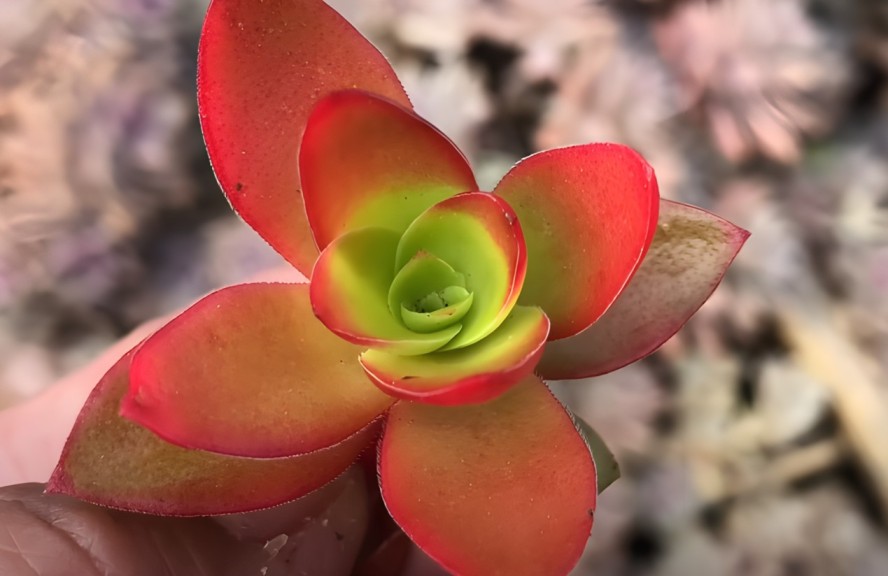
Light Requirement
As this succulent thrives in bright, direct sunlight, Crassula-Capitella is also known as the Campfire Crassula. Sunlight should be available to them for at least 6 hours a day.
In the case of Campfire Crassulas grown indoors, it must be placed inside a window that faces south. Your plant can be moved outside to a sunny location during the summer months.
Avoid sunburn by acclimatizing it gradually to the increased light.
Winter is less light-demanding for Campfire Crassula. A grow light may be required to supplement the light from a south-facing window.
Your Campfire Crassula’s growth rate will be affected by the amount of light it receives. Red leaves are more vibrant on plants that receive more light. Slower-growing and greener plants receive less light.
Here is a table of light requirements by season:
| Season | Light Requirements |
| Spring | 6-8 hours of direct sunlight per day |
| Summer | 6-8 hours of direct sunlight per day |
| Fall | 4-6 hours of direct sunlight per day |
| Winter | 2-4 hours of direct sunlight per day or a grow light |
Water Requirements
As a stunning succulent Campfire Crassula. Despite drought-tolerance, it still requires proper watering for proper blooming, thanks to its plump leaves storing water.
Here’s how to water your plant based on the seasons:
Water your Crassula Campfire more frequently during the summer due to the heat and dry conditions. Depending on local temperatures and humidity, water thoroughly once a week or twice a month. Dry the soil thoroughly between waterings.
As the days grow shorter and cooler in winter, the growth and water requirements of Campfire Plant decline.
Your home’s temperature and humidity levels may determine how often you need to water. Let the soil completely dry between waterings.
Spring and Fall: Maintain a gradual watering schedule during these seasons. As the plant resumes active growth in spring, watering frequency should be increased, and gradually reduced in fall.
Factors Affecting Water Needs
- Larger pots retain moisture longer, so they require less frequent watering.
- The soil mix should drain well, preventing roots from getting soggy.
- A low humidity level means rapid evaporation, which means frequent watering.
- Light encourages faster growth, so brighter areas may require more water.
Soil Requirement
Campfire Crassula grows well in well-drained soil. In addition to providing drainage and aeration, the ideal soil mix should retain moisture.
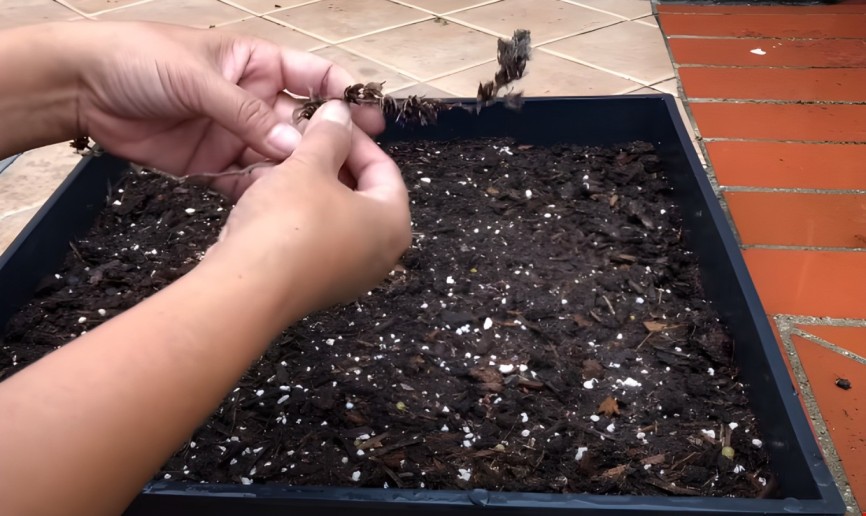
Summer Soil Needs
A heavier soil mix can be beneficial during the summer months when the plant is actively growing. The soil should drain well, yet retain enough moisture to support the plant’s needs. This can include potting mix, coarse sand, and perlite.
Winter Soil Needs
Watering requirements decrease during winter months when the plant goes dormant.
Adding coarse sand or perlite to your soil mix will prevent waterlogging. In addition to preventing root rot, this allows water to drain quickly.
Spring and Fall Soil Needs
It’s ideal to use a balanced soil mix during the spring and fall seasons. Its drainage, aeration, and moisture retention are balanced by a mixture of two parts potting mix, two parts coarse sand, and one part perlite.
Temperature Requirement
The Campfire Plant, or Crassicula Capitella, thrives in warm weather, preferring temperatures between 15°C and 38°C (59°F to 100°F).
Provide ample sunlight and let the soil dry out completely before watering. Fall temperatures should be cooler than 10°C (50°F) at night, so water the plant less.
You can simulate the natural dormancy of your Campfire Plant by placing it in a bright location and reducing its watering.
After nighttime temperatures consistently reach 10°C (50°F), gradually increase watering and move the plant outdoors.
Humidity Requirement
In keeping with its natural South African habitat, your Crassula Campfire prefers low humidity levels. Keep humidity between 30-40% in the sweltering summer months, like in its native arid land.
You can mimic the conditions of a frosty African winter by reducing humidity levels even further as winter approaches.
Keep humidity levels between 40-50% during spring and fall. South Africa’s transitioning seasons are characterized by gradual rises and falls in humidity.
Crassula-Capitellas should be kept away from humidifiers or in excessively damp areas to avoid fungal infections.
Fertilizer Requirement
There is no need for a lot of fertilizer for Campfire Plant. Plants can be damaged by overfertilization.
Once a month, water your Crassula Campfire with a diluted succulent fertilizer solution during the summer.
It is not necessary to fertilize Campfire Plant during the winter months. This plant can be fertilized with diluted succulent fertilizer every other month in the spring and fall.
You can fertilize Crassula Campfire by following these tips
- Fertilize succulents with a low-nitrogen fertilizer.
- Fertilizer should be diluted half way.
- Plant roots should be fertilized, not leaves.
- Following fertilization, water thoroughly.
Potting Requirement
Choose the right pot and potting mix to ensure your Campfire Plant thrives indoors.
Pot Material
- Succulents thrive in terracotta pots, which offer excellent drainage and aeration. Excess water evaporates from their pores, preventing root rot.
Pot Size
- Your Campfire Plant’s rootball should not exceed the size of the pot. Pots that are too large can overwater and damage roots. Grow your plant in bigger pots as it grows.
Drainage Holes
- Waterlogging can be prevented by having adequate drainage holes. Succubus roots rot in soggy soil, so this is crucial.
Potting Mix
- Succulents need a potting mix that drains well. To promote drainage and prevent water retention, these mixes often contain coarse sand, perlite, or pumice.
How to Propagating Crassula Capitella
The propagation of this succulent can be done through several different methods, which are relatively straightforward.
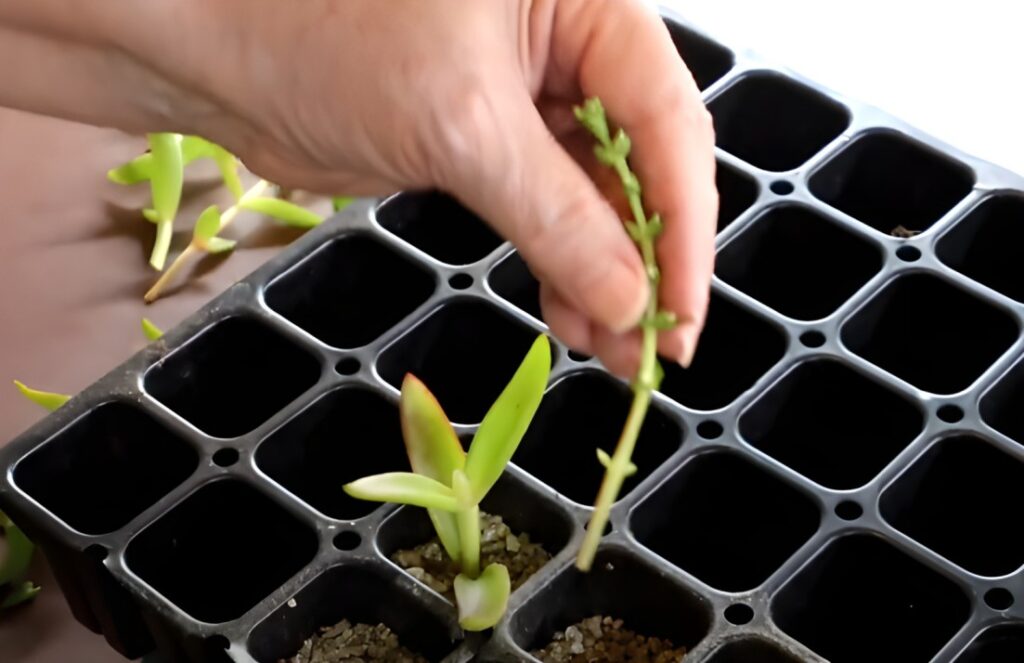
Stem Cuttings
Using stem cuttings is the most convenient way to propagate. Here’s a step-by-step guide:
- You’ll also need sharp scissors and a sterilized knife, potting mix specifically formulated for succulents, and smaller containers.
- Ensure the stems you purchase are healthy, non-flowering, and at least 2-3 inches long. Pests and diseases should not be present.
- Making a clean cut just below the node (the point where each leaf or branch grows from the stem) will create the callus. Prevent rot by allowing the cut end to callus over for 24-48 hours.
- Put the seeds in shallow holes and fill the pots with well-draining potting mix. (Optional, but can promote faster root development) Dip calloused stems in rooting hormone powder. Ensure the calloused end is just below the soil surface when planting the stem.
- Avoid direct contact with the stem when watering and caring for the cutting. Indirect sunlight is best for the pot. Keep the cutting moist by misting occasionally.
- Monitor and repot: New growth should be visible after a few weeks. Tugging the stem gently will show resistance once roots are sufficiently developed. Plants that feel firm need to be replanted.
Leaf Propagation
Campfire Plant is propagated by leaf cuttings, which is less common than stem cuttings. Here’s how:
- Supplies: A healthy Crassula Campfire plant, potting mix specifically designed for succulents, a shallow tray, and a well-draining container will help your plant grow.
- Pick leafy plants with plump, healthy leaves free of blemishes or damage. Take a small piece of stem with you when you twist or pluck the leaves from the stem.
- Leaves need to be laid in a shallow dish or tray filled with a thin layer of well-draining potting mix. For 24-48 hours, let the leaves calluse over.
- If each leaf is not buried too deep, gently place it in the potting mix after callousing. Maintain humidity by misting the leaves.
- Make sure the potting mix is slightly moist, but not soggy. Several weeks after the leaves are cut, new growth should appear. Plants in individual pots should be transplanted once they have developed roots.
Offsets
Occasionally, Crassula-Capitella produces offsets, or pups, at the base of the stem. Offsets can be propagated as follows:
- Ensure offsets have roots attached before gently removing them from the parent plant.
- Ensure the offset’s base is just below soil surface when planting them in small pots or containers filled with well-draining potting mix.
- The soil around offsets should be watered gently without direct contact with the plants. Direct sunlight is best for potted plants.
Growing Problems
Let’s delve into the common growing challenges faced by Crassula Campfire and explore effective solutions to restore their thriving state.
Overwatering
Crassula-Capitella are often overwatered, due to misunderstandings about their succulent nature. They store water in their fleshy leaves to survive in arid environments.
A plant’s health can be quickly deteriorated by excessive watering, leading to root rot.
Symptoms
- Mushy or soft leaves
- Discolored, waterlogged roots
- General decline in plant vigor
Solution
- Between waterings, allow the soil to completely dry out.
- The best way to facilitate the flow of water is to use a well-draining potting mix.
- Instead of watering on a schedule, water the soil at the first sign of dryness.
- Waterlogging can be prevented by choosing a pot with drainage holes.
Insufficient Sunlight
Succulents like Crassula Campfire thrive in bright, sunny conditions. The lack of sunlight can inhibit their growth, causing etiolation, which occurs when stems become elongated and leaves become sparse.
Plant health is also compromised when this occurs, in addition to its aesthetic appeal.
Symptoms
- Pale, elongated stems
- Stretched-out leaf arrangement
- Weak, floppy growth
Solution
- The Campfire Plant must have direct sunlight for at least 6-8 hours a day in a south-facing window.
- Adding a grow light will supplement natural light if it is insufficient.
- Ensure that the plant receives even light distribution and that it does not lean by rotating it periodically.
Pests and Diseases
There are few pests and diseases that affect Campfire Plant, but occasionally infestations can occur, which can cause the plant distress. Powdery mildew, a white fungus, and mealybugs, small cottony insects, can disrupt the plant’s health.
Symptoms
- Leaves and stems are covered in white, cottony masses called mealybugs
- Leaves with a white, powdery coating caused by powdery mildew
Solution
- Neem oil or insecticidal soap are recommended for treating mealybugs.
- The first step in treating powdery mildew is to increase air circulation, reduce humidity, and use a fungicide if necessary.
Soil Issues
In order for Crassula Campfire to thrive, the potting mix has to be of high quality. Root health can be compromised if soil isn’t able to drain, absorb nutrients, and drain properly.
Symptoms
- Slow growth
- Wilting or drooping leaves
- Rootbound plant
Solution
- Make sure the potting mix is well-draining and formulated for succulents.
- The roots need ample space to grow, so repot every 2-3 years.
- Waterlogging can be prevented by ensuring the pot has drainage holes.
Performing pruning and repotting on a regular basis contributes to the overall health and wellbeing of your plants.
Pruning
Keeping your plant healthy and vibrant involves more than just pruning its aesthetics. When it’s time to prune, look for these signs:
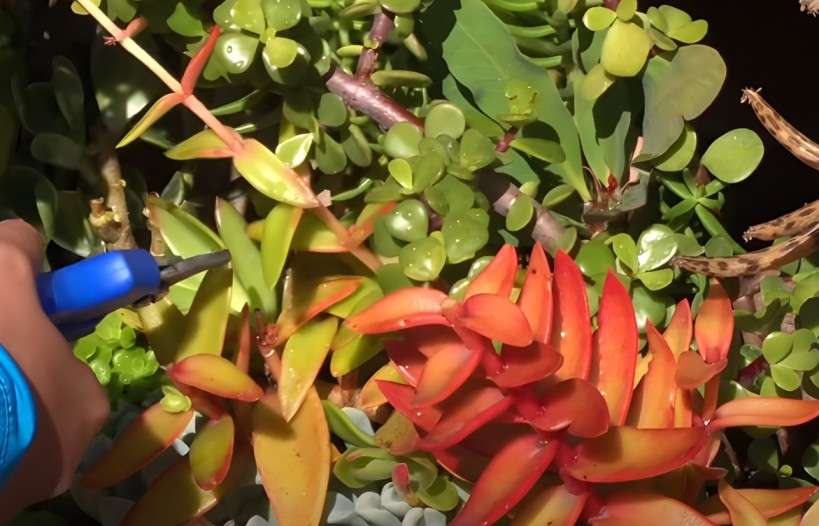
- Pruning can encourage bushier growth and a more compact form if your campfire plant appears stretched and elongated.
- You can encourage your plant to produce healthy, vibrant foliage by removing any dead or diseased leaves.
- Optimal air circulation and preventing overcrowding can be achieved by selective pruning your plant if it is getting too dense, especially with numerous offshoots.
Pruning Techniques
Your Campfire Plant will flourish if you use sharp, sterilized pruning shears. To prune successfully, follow these steps:
- Decide which leaves or stems to remove. Stems that are elongated are leggy. Dead or diseased leaves should be removed selectively.
- Pruning shears are a great tool for making clean cuts just above a healthy node where new growth will emerge.
- Overcrowded plants can be thinned out by removing some of the offshoots, leaving enough room for the remaining plants to grow.
Repotting
If Crassula Campfire grows, its current pot will become too small, restricting root expansion. Plants need ample space to flourish, so repotting every 2-3 years is recommended.
- Make sure the pot has adequate drainage holes by choosing a slightly larger one. A large pot can cause overwatering issues, so don’t oversize it.
- Make sure the drainage holes remain unobstructed when filling the new pot.
- Take your Campfire Plant out of its pot by gently loosening its roots. Encourage roots to spread into the new soil by gently loosing them.
- Place your Campfire Plant carefully in the new pot, making sure the stem base sits slightly above soil level. Fill potting mix around roots, gently firming it.
- Providing initial hydration and settling the soil after repotting is essential. Between waterings, allow soil to dry completely.
How to Get Crassula Capitella to Bloom
Provide Ample Sunlight
It is best to grow Campfire Crassulas in indirect, bright sunlight. Plants need at least six hours of sunlight daily to thrive, so place them in a south-facing window. Insufficient light can prevent flowering.
Encourage Root Boundness
There is a greater chance of blooming for Crassula Campfire that are slightly rootbound. If you are going to repot, choose a pot that is only slightly bigger than the one you are currently using. It is possible for flowering to be delayed by too much space.
Reduce Winter Watering
Allow the plant a period of dormancy during the winter months by watering less frequently. In the spring, this cool, dry period can cause flowering to occur.
Fertilize Sparingly
It is possible for excessive fertilization to discourage flowering, despite its ability to promote growth. While the succulent is actively growing, use a balanced succulent fertilizer that has been diluted to half-strength.
Growth Rate and Size
Succulents such as Crassula Capitella have a moderate growth rate and can reach a mature height of about 6 inches (15 cm) and a width up to 3 feet (90 cm). The plant typically reaches its full size after 2-3 years. Several factors can affect a plant’s growth rate, including light, water, and soil.
Flowering and Foliage

During the summer months, Crassula Campfire produces clusters of small, star-shaped flowers in shades of white or pink. Bees and butterflies are attracted to the flowers by their delicate fragrance.
Its unique growth pattern resembles miniature burning embers, and its foliage is the main attraction. In response to light exposure, the leaves range from pale green to bright red in color.
Campfire Plants are characterized by thick, fleshy leaves arranged in pagoda-like structure. When exposed to bright sunlight or stress, the leaves can turn a vibrant red color.
Spring or summer is the best time to see the plant’s small, star-shaped flowers.
There is a pleasant, citrusy scent associated with the Campfire Plant. Blooming is the best time to notice the fragrance.
Underwatering and Overwatering
The Campfire Plant is a drought-tolerant succulent, so it is important to underwater it rather than overwater it. Overwatering is the most common cause of death for succulents.
Signs of an underwatered Campfire Plant include
- Dry, wrinkled leaves
- Drooping leaves
Signs of an overwatered Campfire Plant include
- Soft, mushy leaves
- Yellowing leaves
- Rotting stems
How to Water a Crassula Capitella
Campfire plants need to be watered thoroughly until the drainage holes drain the excess water from the soil. Before watering again, let the soil completely dry. You may only need to water your Campfire Plant once or twice a month during the winter months.
How to Revive an Underwatered Campfire Plant
Using a humid environment and deeply watering your Campfire Plant can help it recover if it has been underwatered. By placing the pot on a pebble tray filled with water or by placing a humidifier near the plant, you can increase humidity.
How to Save an Overwatered Campfire Plant
A Campfire Plant that is overwatered needs to be treated immediately to prevent root rot. Plants should be removed from their pots and roots should be gently loosening. Make sure any black or mushy roots are removed. Repot the plant in a fresh, well-draining potting mix after that.
Common Pests and Diseases

Despite Campfire Plant’s hardiness, it’s susceptible to pests and diseases. Here are some common culprits to watch out for:
- A mealybug is a tiny white insect that is fluffy with cottony fuzz and gathers on stems and leaves, sucking sap from the plant and weakening it. You can remove them by using a cotton swab dipped in rubbing alcohol.
- Yellowing, growth distortions, and honeydew secretions are caused by these soft-bodied pests. Spray neem oil or insecticidal soap on them.
- Wilting leaves and mushy roots are symptoms of root rot caused by overwatering. Make sure the soil dries completely between waterings.
- Spots, discoloration, and wilting are symptoms of fungal diseases. Reduce fungal issues by improving air circulation and avoiding overhead watering.
Problems and Solutions
Problem: Yellowing Leaves
Solution: Maintain soil moisture without overwatering by ensuring proper drainage and adjusting watering frequency.
Problem: Leggy Growth
Solution: To promote balanced growth and prevent stretching, give the plant more sunlight and rotate it regularly.
Problem: Pest Infestation
Solution: Monitor your plants regularly for pests like aphids and mealybugs, and treat with insecticidal soap or neem oil.
Problem: Leaf Drop
Solutions: Maintain healthy soil conditions by maintaining proper watering habits and removing fallen leaves promptly.
Problem: White Spots on Leaves
Solution: Keep the plant out of direct sunlight during the hottest part of the day and avoid water droplets on the leaves to avoid sunburn.
Problem: Stunted Growth
Solution: Make sure the light conditions are conducive to healthy growth, ensure sufficient sunlight, and consider supplementing with a grow light.
Problem: Brown Tips on Leaves
Solution: Keep the plant in an environment with sufficient humidity to prevent leaf dehydration by following a consistent watering regimen, avoiding underwatering, and avoiding overwatering.
Problem: Drooping or Wilting
Solution: Make sure the soil is moist, adjust your irrigation schedule, and make sure the plant receives sufficient sunlight.
Toxicity
Toxicity in Humans
When consumed, Crassula Capitella leaves can cause mild gastrointestinal distress. Diarrhea, vomiting, and nausea may be symptoms. The plant is unlikely to suffer serious complications, but young children may eat its leaves if they are tempted.
Toxicity in Cats and Dogs
Dogs and cats are more susceptible to Crassula Capitella. More severe symptoms can result from consumption:
- Excessive drooling
- Vomiting
- Diarrhea
- Lethargy
- Loss of appetite
- In rare cases, cardiac irregularities
Crassula Capitella should be treated immediately if it is suspected that your pet has ingested it.
Preventive Measures
Campfire Plant poisoning can be prevented by following these steps:
- Make sure the plant is placed in a high, safe location that pets cannot reach.
- The behavior of your pet around the plant should be monitored.
- You can discourage your pet from interacting with the plant by teaching them the “leave it” command.
Varieties/Types
- Campfire Wonder (Crassula-Capitella Campfire):
- Description: Displayed in bold red tips that simulate flickering flames, the Campfire variety is a fiery addition to any collection.
- Care Tips: Maintain vibrant colors by providing ample sunlight, and water sparingly to prevent overhydration.
- Variegated Elegance (Crassula-Capitella Campfire Variegata):
- Description: The variegated patterns on this variety enhance the allure of the Campfire.
- Care Tips: Follow a well-balanced watering schedule and provide bright sunlight.
- Thyrsiflora Majesty (Crassula-Capitella Thyrsiflora):
- Description: The Thyrsiflora variety boasts stacked leaves with an attractive growth pattern.
- Care Tips: This plant requires well-drained soil to prevent root problems. It thrives in bright light conditions.
- Red Pagoda Splendor (Crassula-Capitella Red Pagoda):
- Description: The Red Pagoda variety is adorned with tiers of red-edged leaves, which give it a sense of sophistication.
- Care Tips: Keep your plants healthy by providing bright, indirect light and watering them regularly.
- Variegated Thriller (Crassula-Capitella Variegated):
- Description: Adding a playful touch of color to your succulent garden, this variety has variegated leaves.
- Care Tips: Water when the soil feels dry to the touch, and keep the environment well ventilated.

Uses
- Eye-Catching Décor: Decorate indoors or outdoors with Crassula Capitella, a standout choice for stylish decor because of its unique growth patterns.
- Table Centerpiece: Potted Campfire Plant makes for stunning table arrangements due to its compact size and appealing structure.
- Living Gifts: Gift potted succulents, representing prosperity and resilience, for a thoughtful touch.
- Natural Air Purifier: Through photosynthesis, the Crassula Campfire absorbs toxins and releases oxygen to improve indoor air quality.
- Container Gardening: Use Crassula Campfire for container gardening, adaptable to different pot sizes and soil types.
- Educational Tool: Introduce children and gardening enthusiasts to succulent care, growth cycles, and environmental impact by using Cressula Capitella as an educational tool.
- Natural Stress Reliever: Crassula Capitella, a plant that relieves stress and promotes well-being, can be cultivated.
- Crafting and DIY Projects: Add a touch of artistic flair to terrariums and wreaths by incorporating Cressula Capitella.
- Sustainable Living: Introduce Campfire Plant to your garden to cultivate low-maintenance, environmentally friendly plants.
Optimal Care for Crassula Capitella: Watering, Sunlight, and Disease Prevention
Caring for a Crassula capitella, commonly known as the Red Pagoda, requires attention to specific care guidelines to ensure its health and vitality. Proper care involves understanding its water needs, as overwatering can lead to diseases and root rot.
It’s crucial to follow a regular watering schedule, allowing the soil to dry out between watering sessions. The frequency of watering may vary depending on factors like climate and the specific conditions of your indoor or outdoor environment.
Additionally, providing well-draining soil and ensuring proper sunlight exposure are essential components of successful care for this succulent.
Diverse Varieties of Campfire Plant: Campfire, Thyrsiflora, and Propagation Techniques
Among the various varieties and types of Crassula Campfire, the Campfire and Campfire Variegata are notable for their striking appearance. The Campfire variety, with its vivid red tips resembling flames, requires careful attention to sunlight exposure and watering to maintain its vibrant colors.
Meanwhile, the Campfire Variegata adds an extra layer of visual interest with variegated patterns. Propagation of these varieties can be achieved through methods such as leaf cuttings or offsets, allowing you to expand your collection and share the beauty of these unique succulents.
Identifying and naming different types, such as the Thyrsiflora, involves understanding their specific characteristics and common names, contributing to a comprehensive knowledge of this diverse plant species.
Whether you’re exploring specific varieties or delving into miscellaneous information about Crassula Campfire, such as its use in homeopathy or available images, each aspect contributes to a holistic understanding of caring for and appreciating this captivating succulents.
FAQs
How do you care for Crassula capitella?
Make sure the soil drains well, that there is plenty of sunlight, and that it doesn’t need to be watered frequently.
Plants should be replanted every 2-3 years and fallen leaves should be removed.
What is Crassula capitella used for in medicine?
To treat wounds and relieve skin irritations, powdered roots and extracts are used in traditional medicine.
What is the common name for Crassula capitella?
The common name for Crassula capitella is Campfire Plant
Is Crassula capitella an indoor plant?
Plants like this can be grown indoors as ornamental plants.
Is Crassula capitella toxic?
Ingestion of this product can be mildly toxic to pets.
How tall is Crassula capitella?
Typically reaches a height between 6 and 12 inches (30 and 45 cm).
How do you propagate Crassula capitella?
Plant stem cuttings in soil that drains well after they have become callous.
Why is my Crassula Campfire turning green?
When the plant receives less sunlight, its red color may fade and it may revert to a greener hue.
How often should you water a Crassula Campfire?
The soil should be allowed to completely dry between waterings, usually every 1-3 days.

